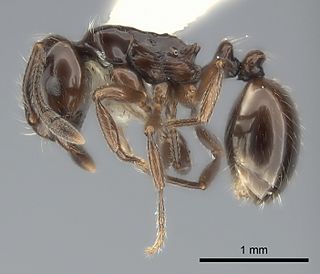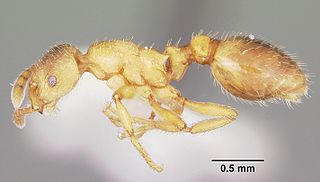
Monomorium bidentatum is a species of ant in the subfamily Myrmicinae. It is endemic to two South American countries, Chile and Argentina.

Leptothorax pacis is a species of ant in the genus Leptothorax. It is endemic to Switzerland.

Ravoux's slavemaker ant is a species of slave-making ant endemic to Europe. The species are helotistic, that is, they oppress another species of ant in order to sustain their colony. The queen will fake death to entice ants from another colony to drag her back to their nest, where she awakens and kills the nest's original queen. She will then cover herself in the dead queen's pheromones, and will begin producing eggs. The slavemaker ants then overrun the colony and then find a new colony to take over.

Formicoxenus nitidulus, or the shining guest ant, is a species of ant in the subfamily Myrmicinae. It is found in Austria, Denmark, Finland, France, Germany, Great Britain, Italy, Norway, Poland, Russia, Spain, Sweden, and Switzerland. The International Union for Conservation of Nature has assessed it as being a vulnerable species.

Formicoxenus provancheri, common name shampoo ant, is a species of ant in the subfamily Myrmicinae. It is found in Canada and the United States.
Formicoxenus sibiricus is a species of ant in the genus Formicoxenus. It is endemic to Russia.
Monomorium effractor is a species of ant in the genus Monomorium. It is native to India.
Monomorium hospitum is a species of ant in the genus Monomorium. It is native to Singapore.
Monomorium inquilinum is a species of ant in the genus Monomorium. It is native to Mexico.

Monomorium noualhieri is a species of ant endemic to Algeria.

Monomorium pergandei is a species of ant in the genus Monomorium. It is native to the United States. The species is named after the American myrmecologist Theodore Pergande.

Monomorium talbotae is a species of ant in the genus Monomorium. It is native to the United States. It is named after entomologist Mary Talbot.
Myrmoxenus gordiagini is a species of slave-making ant in the genus Myrmoxenus. It is found in Croatia and Russia. Its natural habitat is temperate forests.

Polyergus samurai is a species of slave-making ant in the subfamily Formicinae.

Temnothorax americanus is a species of slave-maker ant in the genus Temnothorax. The ants are 2–3 mm in size, and endemic to the northeastern United States and adjacent Canadian regions. They do not forage for food, but instead 'scout workers' from the colony seek out nearby host colonies of ants, steal larvae and bring them back to their own colony. A small T. americanus colony could consist of a queen, two to five workers and thirty to sixty slaves.

Pseudoatta is a genus of ant in the subfamily Myrmicinae. It contains the single species Pseudoatta argentina, native to Argentina.
Strongylognathus afer is a species of ant in the genus Strongylognathus. It is endemic to Algeria.
Strongylognathus chelifer is a species of ant in the genus Strongylognathus. It is endemic to Ukraine.
Strongylognathus christophi is a species of ant in the genus Strongylognathus. It is endemic to Russia.
Strongylognathus destefanii is a species of ant in the genus Strongylognathus. It is endemic to Italy.











